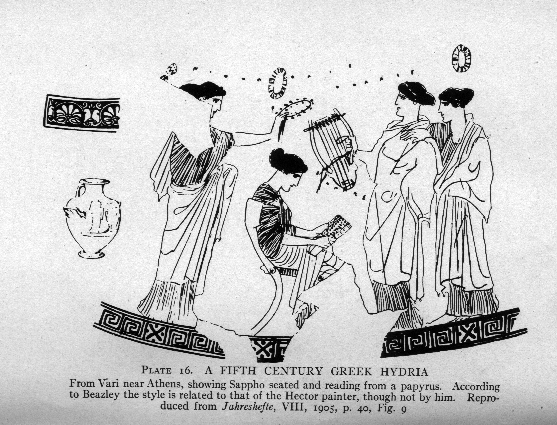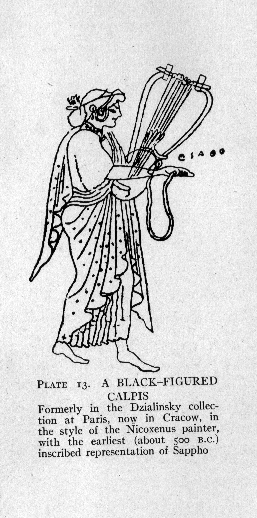
|
|
|
|
|
|
|
|
|
|
|
|
|

Truth and honesty have carried the mysterious Sappho through time.
When Sappho expressed “her” world through poetry, song, and public worship
she spoke for many women of her time. The true knowledge of her is
controversial because she never actually wrote any of her work herself.
Attributed for having the only surviving lyric women’s poetry created during
the Hellenistic era, Sappho still baffles and challenges the scholar of
today to truly understand her work. Others just accept her as an
icon to fulfill the truth of women over the ages. To truly appreciate
the fragments of Sappho’s aesthetic response to her world, one should read
and let the works enhance the history of Sappho for each individual.
A woman during the rise of the polis in the Hellenistic period of 5th
Century B.C. had little to say publicly about her fate or role in life.
Sappho was born on the island of Lesbos and spent a brief amount of time
in Sicily. She is said to have been of the aristocracy, due to varied
reports of her brother’s business ventures in Egypt and the belief that,
if she had not been, she would have been put to death for her outward voice
about women’s sexuality. Her days consisted of public worship ceremonies,
called Thesmophorias, to female Gods, such as Aphrodite, possibly attending
religious choir settings, and of course typical female chores of the home.
During these small group meetings, women were believed to have spoken freely
about their feelings. Once these meetings where over, they had to
return home to their husbands or fathers and resume an extremely submissive
role in society. Some scholars believe the island of Lesbos allowed
women to have more of a free life than other Greek polis at this time refute
this idea. These sessions fostered the creations of Sappho, her label
of being the first female poet, by some, may only be so because her works
alone, have survived and been translated through various languages over
time.

Sappho created history about the period in which she lived through
a verbal expression of herself in poetic style. Frustrations of love,
marriage, sexuality, oppression, and confusion over a changing world around
her are believed to be the focus of her works. She composed wedding
songs admiring brides to be. She also expressed ideas of feelings
toward loss of virginity due to marriage. Many of her poems are attributes
to the Goddess Aphrodite, for love to come her way. Based on Historical
study, she seems to put herself on equal standing with the Goddess Aphrodite,
as if they are friends. Her willingness to equalize herself to a
God was similar to what men did at this time to gain power, become rulers.
Some may have adored her simply out of fear of the Gods if they did not.
She was listened to and taught many young girls who memorized her words.
Had she not been translated as a lover of other women, many Catholics throughout
the Renaissance may have preserved her memory and writings rather than
destroying them.
The type of literature around the time, 800-500B.C., was called Lyric Poetry, named so because much of public spoken poetry was accompanied by the playing of a Lyre. It has been suggested she may have originated the stanza form of writing in poetry some call the Sapphic stanza. This was a change from the social standards set in the writings of Homer’s Odyssey. It was a focus of expression of self. These beliefs have clouded scholars’ ability to judge whether Sappho was lesbian or just regarded women highly above men. It has also created ignorance in her shire literary ability.
Recently Sappho’s writings have been detailed as having specific female genres for better understanding. These genres have been addressed as laments, praises of young brides, and prayers to female Goddesses. Of the nine books believed to have been constructed, only one complete work remains intact and several fragments are interpreted, as they exist leaving much to the imagination or creation of others in an attempt to translate her work. In her laments, Sappho expresses grief, not of the dead, but of parting of female friends after having spent time with them. These times where often described as going for walks, fixing hair, or just her teaching women’s rights for the time. Her praises of young brides are largely songs of frustration, joy, passion, sympathy, or understanding for what the young brides may be feeling. Men saw women as a prize or game for sex and had little, to no respect of a woman’s desires. Looking at women’s social history over centuries, this lack of understanding and appreciation for women would have created a strong bond between women who where not lesbian.
Sappho’s honesty about her inner feelings regarding women has
carried through time on a negative view and an inspiring one. Her
poems have been used as a vehicle both for and against homosexuality all
over the world. Because she shared herself, we can understand the
society of her time. Men of high regard and philosophers such as,
Plato, who called her the “tenth muse” and Aristotle where willing to speak
of her work giving it importance, having been written by a woman.
Having this strong backing is what saved her work from destruction.
The use or, as some have said, abuse of her work by the poets Ovid and
Horace may have induced comedy at the time, but also helped to pass along
the messages women had inside. Her poetry is the most personal that
has survived antiquity and because it is so passionate, it has often been
miss understood through translation. All women should feel inspired
by one woman’s voice of truth centuries ago changing the course of history
for women both in openness of their sexuality as well as literary acceptance
as writers.
Sappho’s main attribute to us is her poetic style. It has carried
her through time. The content of her poems have created scandalous
interest which whether good or bad has exposed the poetry to more readers.
She may have invented the metaphoric style or merely refined it, but either
way she has prompted minds thinking about her, which is what she predicted,
a very smart woman not one just frustrated by her role in society.
One woman at a time has been changed and exposed to the idea of speaking
the honest, truth, and standing up for equality for women.
Sappho has been strengthening and changing the views of many twentieth
century women and many have not even known it. Since her works where
translated women all over the world have used her teachings and expressions
of love to enhance their own lives and others as well. Several of
her fragments have been used by songwriters and have gone on to become
famous, even culture changing songs. Two such numbers are Madonna’s,
“Like a Virgin,” taken from Fragment 114, ‘where are you, virginity?’ and
Diana Ross’s “Where did our love go?” from Fragments 130 and 146.
Sappho may seem to most as just another Greek poet, but she is much more. Through time she has inspired woman that are lesbians to believe in who they are. Today a statue stands on the island of Lesbos in her memory. To inspire and give history to the lesbian community today she stands as an icon in a traveling display of her fragmented work and significance to women. “The Sappho Project,” a nonprofit organization of artists and administrators has recently created rental displays that educate on her life from the beginning and how it has affected western civilization through today. Therefore, through this organization she still is given a voice and her belief in women’s rights whether lesbian or not will continue to encourage the belief that one voice can change the world.
To truly preserve the ideals of Sappho and her work we must remember
that none of her work was actually written by her. During this transitional
period in history toward a literate society, at least with in the aristocracy,
paper did not exist. Its through her teaching, memorizing, and passing
down through generations, of art work, and the support of intellectual
men of antiquity that today’s woman can experience the importance of each
individual woman’s significance to the future generations of women.
Greene, Ellen. (1996). Re-Reading Sappho Reception and Transmission. (9th ed.). London: University of California Press, Ltd.
Lardinois, A. & McClure, L. (2001). Making Silence Speak(10th ed.). Princeton: Princeton University Press.
McIntosh Snyder, Jane. (1989). The Woman and the Lyre Women Writers in Classical Greece and Rome(4th ed.). Jorgenson-Buhman.
Prins, Yopie. (1999). Victorian Sappho(10th ed.). Princeton: Princeton University Press.
Reynolds, Margaret. (2000). The Sappho Companion(1st ed.). London: Chatto & Windus Random House.
Robinson, David M. PhD., LL.D. (1924). Sappho And Her Influence(1st ed.). Norwood, MS: The Plimpton Press.
Stehle, Eva. (1997). Performance and Gender in Ancient Greece Nondramatic Poetry In Its Setting(10th ed.). Princeton: Princeton University Press.
The Greek Lyric Poets: John Porter briefly relates the sexuality discussed in her work.
Sappho: The Academy of poets discuss a history of her and what was done with her work. This site also provides an extensive link to similar sites.
Sappho The Eressia c.613BC-c.570BC: A Look at Sappho’s life during the Hellenistic Period.
Sappho, the first modern poet: A brief history of her poetry.
The
Sappho Project : A non-profit organization telling her story through
a rental display.